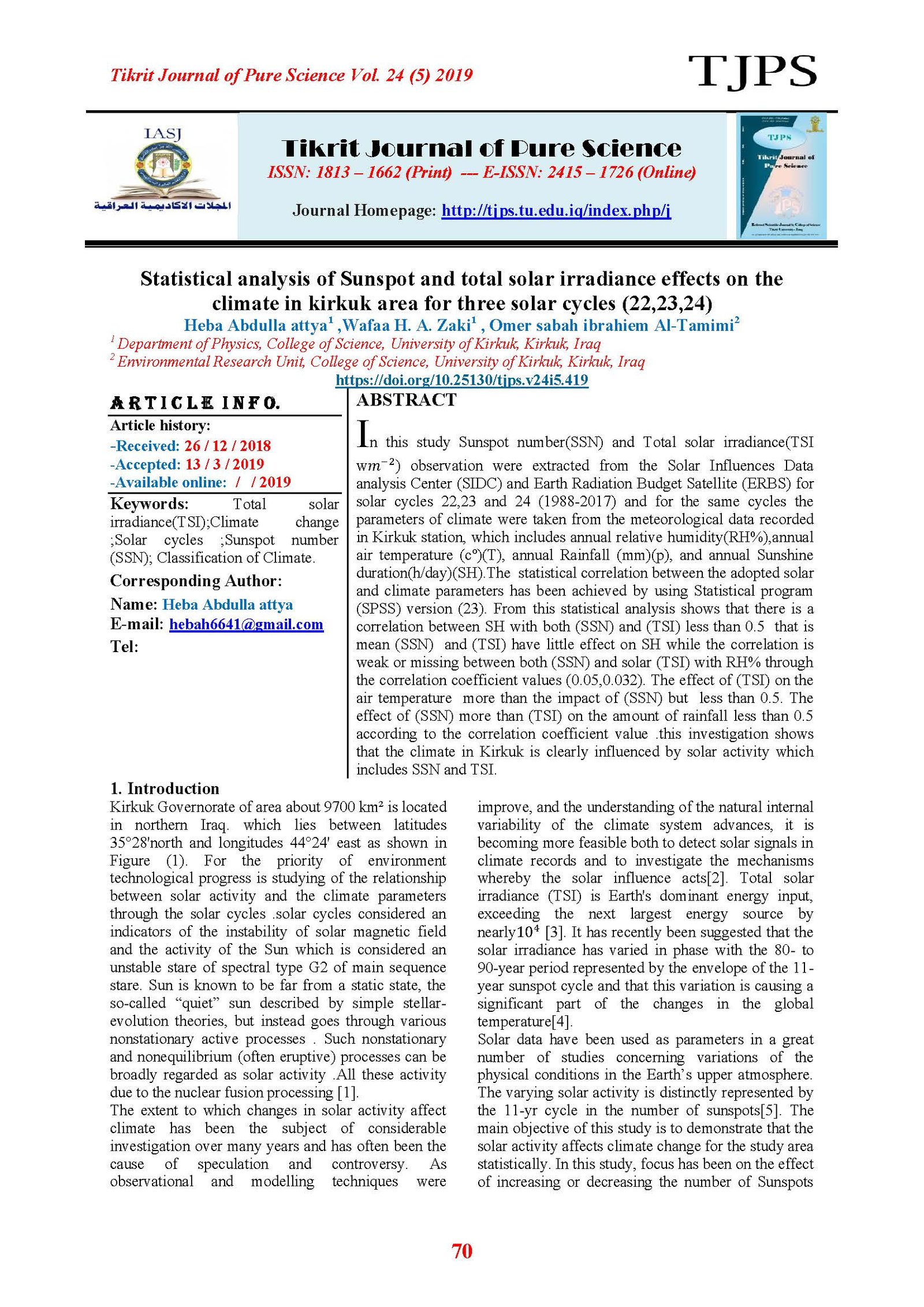Statistical analysis of Sunspot and total solar irradiance effects on the climate in kirkuk area for three solar cycles (22,23,24)
Main Article Content
Abstract
In this study Sunspot number(SSN) and Total solar irradiance(TSI w ) observation were extracted from the Solar Influences Data analysis Center (SIDC) and Earth Radiation Budget Satellite (ERBS) for solar cycles 22,23 and 24 (1988-2017) and for the same cycles the parameters of climate were taken from the meteorological data recorded in Kirkuk station, which includes annual relative humidity(RH%),annual air temperature (cº)(T), annual Rainfall (mm)(p), and annual Sunshine duration(h/day)(SH).The statistical correlation between the adopted solar and climate parameters has been achieved by using Statistical program (SPSS) version (23). From this statistical analysis shows that there is a correlation between SH with both (SSN) and (TSI) less than 0.5 that is mean (SSN) and (TSI) have little effect on SH while the correlation is weak or missing between both (SSN) and solar (TSI) with RH% through the correlation coefficient values (0.05,0.032). The effect of (TSI) on the air temperature more than the impact of (SSN) but less than 0.5. The effect of (SSN) more than (TSI) on the amount of rainfall less than 0.5 according to the correlation coefficient value .this investigation shows that the climate in Kirkuk is clearly influenced by solar activity which includes SSN and TSI.
Article Details

This work is licensed under a Creative Commons Attribution 4.0 International License.
Tikrit Journal of Pure Science is licensed under the Creative Commons Attribution 4.0 International License, which allows users to copy, create extracts, abstracts, and new works from the article, alter and revise the article, and make commercial use of the article (including reuse and/or resale of the article by commercial entities), provided the user gives appropriate credit (with a link to the formal publication through the relevant DOI), provides a link to the license, indicates if changes were made, and the licensor is not represented as endorsing the use made of the work. The authors hold the copyright for their published work on the Tikrit J. Pure Sci. website, while Tikrit J. Pure Sci. is responsible for appreciate citation of their work, which is released under CC-BY-4.0, enabling the unrestricted use, distribution, and reproduction of an article in any medium, provided that the original work is properly cited.
References
[1] Usoskin, I. G. (2017). A history of solar activity over millennia. Living Reviews in Solar Physics, 14(1), 3.
[2] Haigh, J. D. (2003). The effects of solar variability on the Earth's climate. Philosophical Transactions of the Royal Society of London A: Mathematical, Physical and Engineering Sciences, 361(1802), 95-111.
[3] Kopp, G., & Lean, J. L. (2011). A new, lower value of total solar irradiance: Evidence and climate significance. Geophysical Research Letters, 38(1).
[4] Stauning, P. (2011). Solar activity–climate relations: A different approach. Journal of
Atmospheric and Solar-Terrestrial Physics, 73(13), 1999-2012.
[5] Lassen, K., & Friis-Christensen, E. (1995). Variability of the solar cycle length during the past five centuries and the apparent association with terrestrial climate. Journal of Atmospheric and Terrestrial Physics, 57(8), 835-845.
[6] Willson, R. C., Gulkis, S., Janssen, M., Hudson, H. S., & Chapman, G. (1981). Observations of solar irradiance variability. Science, 211(4483), 700-702.
[7] https://www.ngdc.noaa.gov/stp/solar/solarirrad.html.
[8] http://sidc.oma.be./sunspot-data.
[9] Iraqi Meteorological Organization. 2017. Climatic data for kirkuk station, for period from (1984-2014) (un published internal report).
[10] da Cunha, A. R., & Schöffel, E. R. (2011). The evapotranspiration in climate classification. In Evapotranspiration - From Measurements to Agricultural and Environmental Applications. In Tech.
[11] Al-Kubaisi, Q.Y. 2004. Annual aridity index of type.1 and type.2 mode options climate classification, Science Journal, 45c(1), pp:32-40.
